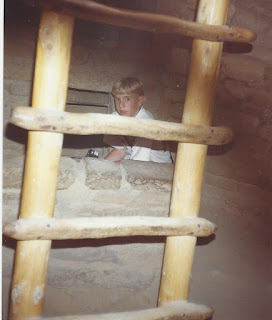An archeological field seminar! What could be better for a young man who is
interested in history, I thought, and here is ancient history indeed – in
America’s Southwest, in the area inhabited by the Anasazi – a civilization
which mysteriously disappeared around 1200 A.D.
 |
| Indiana Martin, the budding archaeologist! |
This Anasazi riddle has intrigued archeologists for a long
time, and there are many excavations in the area. Crow Canyon Archaeological Center in 1993
offered a look at the area from two perspectives on the same trip: a four day
land tour and a three day river tour of rafting on the San Juan River. From the River, we saw 350 million years of
geological time exposed in walls that often rose 2000 feet above the river. And it is only from the river that one can
see some of the most varied displays of ancient rock art in the Southwest. Off
Martin (who was almost 14 at the time) and I went for 8 wonderful days of
exploration and learning!
Courtesy of Smithsonian Magazine (July 2003),
here is a bit of background about the Anasazi:
The Anasazi was …”a
civilization that arose as early as 1500 B.C. Their descendants are today’s
Pueblo Indians, such as the Hopi and the Zuni, who live in 20 communities along
the Rio Grande, in New Mexico, and in northern Arizona. During the 10th and
11th centuries, Chaco Canyon, in western New Mexico, was the cultural center of
the Anasazi homeland, an area roughly corresponding to the Four Corners region
where Utah, Colorado, Arizona and New Mexico meet. This 30,000-square-mile
landscape of sandstone canyons, buttes and mesas was populated by as many as
30,000 people. The Anasazi built magnificent villages such as Chaco Canyon’s
Pueblo Bonito, a tenth-century complex that was as many as five stories tall
and contained about 800 rooms. The people laid a 400-mile network of roads,
some of them 30 feet wide, across deserts and canyons. And into their
architecture they built sophisticated astronomical observatories.
For most of the long span
of time, the Anasazi occupied the region now known as the Four Corners, they
lived in the open or in easily accessible sites within canyons. But about 1250,
many of the people began constructing settlements high in the
cliffs—settlements that offered defense and protection. These villages, well
preserved by the dry climate and by stone overhangs, led the Anglo explorers
who found them in the 1880s to name the absent builders the Cliff Dwellers.
Toward the end of the 13th
century, some cataclysmic event forced the Anasazi to flee those cliff houses
and their homeland and to move south and east toward the Rio Grande and the
Little Colorado River. Just what happened has been the greatest puzzle facing
archaeologists who study the ancient culture.”
First stop: Mesa Verde National Park, to visit the
spectacular cliff dwellings. Plenty of
lookout points to view the “Four Corners” geography!
 |
| Our group explored the cliff dwellings at Mesa Verde |
There are over 600 cliff
dwellings found at Mesa Verde. The
dwellings were tucked into the 500 to 600 foot high walls of the canyons.
Next, onto the San Juan
River! We enter the river near Bluff
Utah. The river can be smooth or have rapids, depending on where we are...
Our trip down the river
included camping on the riverbanks each night.
Every day we explored the
river banks, to see the rock art up close.
We are always on the
lookout for pottery shards.
One way to beat the heat:
After three days on the
river, we disembark at Mexican Hat, Utah.
We boarded 4-wheel drive
vehicles for the trip to Monument Valley.
Martin was the favorite of the grizzled older archeologist (we had two
“arkies” on this trip) and insisted that Martin ride shotgun in the front of
the car which he was driving, so he could fill Martin’s brain with the wonders
of archaeology.
We learned how rock
formations in Monument Valley were created over millions of years.
A special treat was a
short hike around Yazzie Mesa, where we visited Susie Yazzie’ sheep camp. Susie is a matriarch of a Navajo family that
is quite well known in the area.
We saw some Navajo weaving
techniques in Susie Yazzie’s Hogan.
Then we drove to Sand
Springs to examine a traditional Navajo forked stick Hogan.
The next day, we got in
vans to go to Chinle, Arizona. Chinle
Wash was made famous as “Many Ruins Canyon” in the book by Tony Hillelrman, “A
Thief of Time”. It is part of the Canyon de Chelly park.
We toured the Canyon de
Chelly. Here there are several
archaeological sites that are in pristine condition under great rock
overhangs. We visited Antelope House and
White House ruins. There are many panels
here of historic and prehistoric rock art on the canyon walls.
At the Crow Canyon Center
in Cortez, we visited the laboratories and education facilities.
On the final day of this
archeological trip and “seminar”, we visited archaeologists who are excavating
a 13th Century Anasazi ruin in Sand Canyon. This 400-room pueblo may have been one of
the last Anasazi ceremonial centers and towns occupied before this civilization
suddenly abandoned the Four Corners area.
At Castle Rock, we took
this group photo. Great adventure!

























